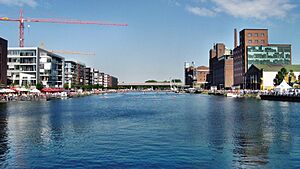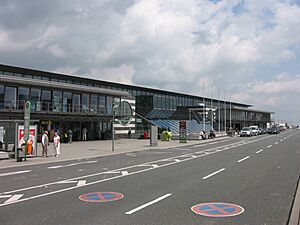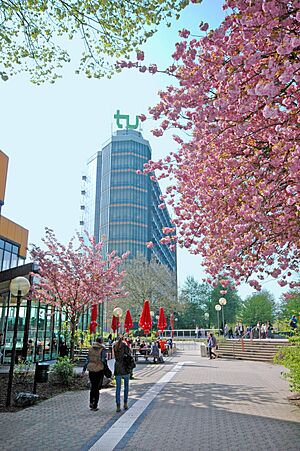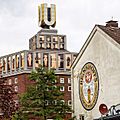Ruhr Area facts for kids
Quick facts for kids
Ruhr Metropolitan Region
Metropolregion Ruhr
|
|
|---|---|
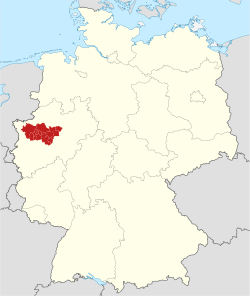
map of the Ruhr metropolitan region within Germany
|
|
| Country | |
| State | |
| Largest Cities | Dortmund Essen Duisburg Bochum |
| Government | |
| • Body | Regionalverband Ruhr |
| Area | |
| • Metro | 4,435 km2 (1,712 sq mi) |
| Highest elevation | 441 m (1,447 ft) |
| Lowest elevation | 13 m (43 ft) |
| Population | |
| • Metro | 5,172,745 |
| • Metro density | 1,646/km2 (4,260/sq mi) |
| Time zone | UTC+1 (CET) |
| GRP | 2007 |
| Nominal | € 136.3 billion |
| Website | www.metropoleruhr.de |
The Ruhr Area (also called Ruhrgebiet in German) is a very large group of cities in North Rhine-Westphalia, Germany. It is one of the biggest urban areas in Europe. Many cities here used to be centers for heavy industry, like making steel and mining coal.
The Ruhr Area is surrounded by important rivers. The Ruhr River is to the south, the Rhine River is to the west, and the Lippe River is to the north. To the southwest, it borders a region called the Bergisches Land.
About 5.3 million people live in the Ruhr Area. It is also part of an even larger area called the Rhine-Ruhr metropolitan area, which has over 12 million people.
Contents
Cities of the Ruhr Area
The Ruhr Area is made up of many different cities and districts. These cities work together to make the region a great place to live and visit.
Some of the main cities include:
- Duisburg
- Oberhausen
- Bottrop
- Mülheim an der Ruhr
- Essen
- Gelsenkirchen
- Bochum
- Herne
- Hamm
- Hagen
- Dortmund
There are also rural districts that are part of the Ruhr Area. These include Wesel, Recklinghausen, Unna, and Ennepe-Ruhr.
From Industry to Innovation
For a long time, the Ruhr Area was famous for its heavy industry. This meant a lot of factories that made steel and many coal mines. These industries were very important for Germany's economy.
Over the years, many of the mines and factories closed down. But the Ruhr Area did not stop growing! It changed from an industrial area to a center for new technologies, services, and culture. Many old industrial sites have been turned into parks, museums, or event venues.

Culture and Fun
The Ruhr Area has a rich culture and many exciting things to do. In 2010, the city of Essen was chosen as the European Capital of Culture. This was a big honor and showed how much the region has changed.
You can find many theaters, museums, and concert halls here. There are also lots of green spaces and parks where people can relax and play. The region often hosts big events and festivals.

Getting Around
The Ruhr Area has a very good transport system. It is easy to travel between the different cities.
- Roads: Major highways like the Bundesautobahn 52 and the A40 connect the cities.
- Air Travel: Dortmund Airport is located in the eastern part of the region, making it easy to fly in and out.
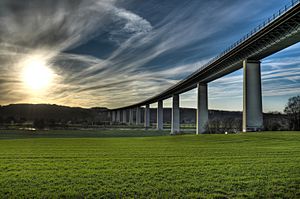
Learning and Education
The Ruhr Area is also home to many universities and colleges. These institutions attract students from all over the world. They offer a wide range of subjects, from science and engineering to arts and humanities.
Some well-known universities include:
- Ruhr University Bochum
- TU Dortmund University
- University of Duisburg-Essen
- Folkwang University of the Arts
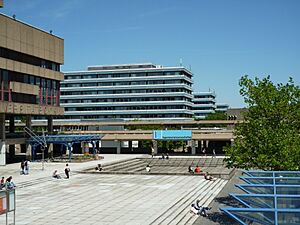
Images for kids
-
Zeche Zollern in Dortmund
-
Dortmund is the largest city of the Ruhr
-
Essen is the second largest city of the Ruhr
-
A40 in Dortmund
See also
 In Spanish: Región del Ruhr para niños
In Spanish: Región del Ruhr para niños


